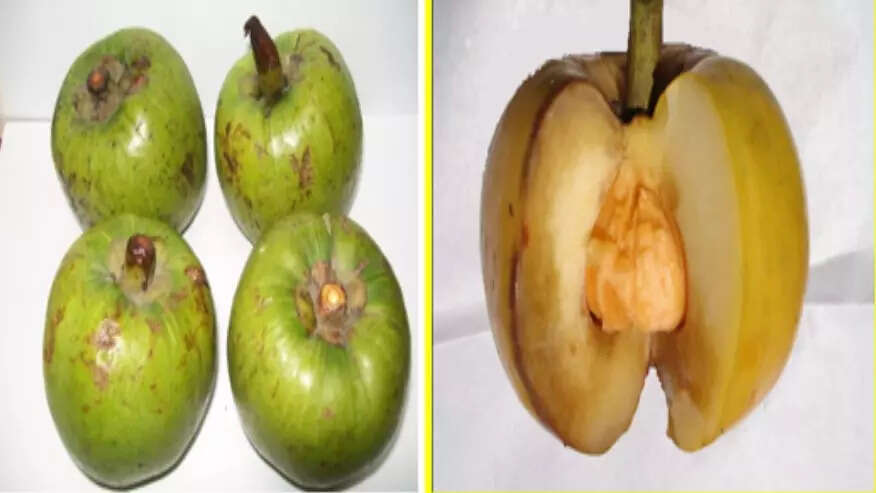Latest Education news – Board Exam Results, Admit Cards, Exam Paper Analysis and Question Papers | Times of India
NEW DELHI: Commonly known as ‘Borthekera‘ in Assamese, Garcinia pedunculata, a medicinal plant has been found to protect from heart diseases. Scientists of Institute of Advanced Study in Science and Technology (IASST), an autonomous institute of the department of science and technology (DST), reported the findings where it is said that the sun-dried slices of the ripe fruit are used for culinary and medicinal purposes and are known to have therapeutic properties like anti-inflammatory, anthelmintic, antibacterial, antifungal, antidiabetic, hypolipidemic, nephroprotective, and even neuroprotective activity.
Traditionally forbidden for raw consumption, in Assam, dried slices are used for preparing delicacies like “tenga diya masor jol” (sour fish curry). It can also be prepared with other vegetables, especially fritters made with lentils. A traditional Assamese home also used to soak it in water and the liquid as home remedy for stomach problems.
Administration of the dried pulp of the ripe fruit of the medicinal plant reduced cardiac hypertrophy indicators and oxidative stress and heart inflammation brought on by isoproterenol (ISO).
With scientific interventions seeking proof of these claims, multiple studies have been reported that G pedunculata is a rich source of antioxidants. However, the cardioprotective potential has yet to be explored earlier.
Scientists of IASST explored this medicinal plant’s potential to prevent heart diseases. A double dosage of bioactive chloroform fraction (GC) of the herb was fed to Wistar rats at 24-hour intervals (85mg/kg body weight (BW) for 28 days.
To assess the therapeutic effect, this was followed by injection of isoproterenol following the isoproterenol-induced myocardial infarction model. All the animals were analyzed, revealing that the disease group had significant ST wave (ST is the segment representing the interval between depolarization and repolarization of the heart’s ventricles) elevation, indicating myocardial infarction, which was normalized with Atenolol and GC treatment. Cardiac hypertrophy, cardiac troponin I, tissue lipid peroxidation, and serum inflammatory markers were all significantly elevated in the disease group, which were maintained at near-normal levels in the GC pretreated groups. The endogenous antioxidants were also revamped in the GC-treated groups.
Swarnali Bhattacharjee, senior research fellow, under the supervision of Rajlakshmi Devi, have attributed these improvements to the excellent antioxidant and anti-inflammatory potential of GC that helped protect the heart against isoproterenol-induced injury.
Moreover, the chemical characterization of the chloroform fraction revealed the presence of active phytocompounds like hydroxycitric acid, hydroxycitric acid lactone, and parvifoliquinone along with compounds like GB-1a, Garcinone A, 9-Hydroxycalabaxanthone, Chlorogenic acid, and Garcinol as well. The therapeutic effects reported in this study are likely due to the presence of all these compounds. All these results strongly infer the good cardioprotective potential of G pedunculata fruit abundantly available in Northeast India.
Traditionally forbidden for raw consumption, in Assam, dried slices are used for preparing delicacies like “tenga diya masor jol” (sour fish curry). It can also be prepared with other vegetables, especially fritters made with lentils. A traditional Assamese home also used to soak it in water and the liquid as home remedy for stomach problems.
Administration of the dried pulp of the ripe fruit of the medicinal plant reduced cardiac hypertrophy indicators and oxidative stress and heart inflammation brought on by isoproterenol (ISO).
With scientific interventions seeking proof of these claims, multiple studies have been reported that G pedunculata is a rich source of antioxidants. However, the cardioprotective potential has yet to be explored earlier.
Scientists of IASST explored this medicinal plant’s potential to prevent heart diseases. A double dosage of bioactive chloroform fraction (GC) of the herb was fed to Wistar rats at 24-hour intervals (85mg/kg body weight (BW) for 28 days.
To assess the therapeutic effect, this was followed by injection of isoproterenol following the isoproterenol-induced myocardial infarction model. All the animals were analyzed, revealing that the disease group had significant ST wave (ST is the segment representing the interval between depolarization and repolarization of the heart’s ventricles) elevation, indicating myocardial infarction, which was normalized with Atenolol and GC treatment. Cardiac hypertrophy, cardiac troponin I, tissue lipid peroxidation, and serum inflammatory markers were all significantly elevated in the disease group, which were maintained at near-normal levels in the GC pretreated groups. The endogenous antioxidants were also revamped in the GC-treated groups.
Swarnali Bhattacharjee, senior research fellow, under the supervision of Rajlakshmi Devi, have attributed these improvements to the excellent antioxidant and anti-inflammatory potential of GC that helped protect the heart against isoproterenol-induced injury.
Moreover, the chemical characterization of the chloroform fraction revealed the presence of active phytocompounds like hydroxycitric acid, hydroxycitric acid lactone, and parvifoliquinone along with compounds like GB-1a, Garcinone A, 9-Hydroxycalabaxanthone, Chlorogenic acid, and Garcinol as well. The therapeutic effects reported in this study are likely due to the presence of all these compounds. All these results strongly infer the good cardioprotective potential of G pedunculata fruit abundantly available in Northeast India.
Source link
Manash Pratim Gohain
#Medicinal #plant #commonly #called #Borthekera #Assamese #cardioprotective #potential #Times #India
